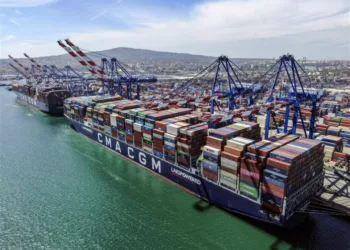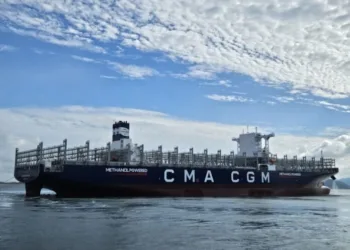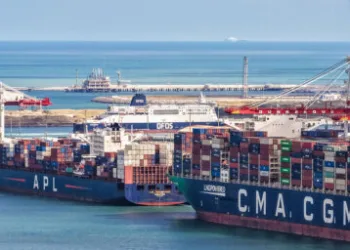The quarterly letter to investors from Triumph Capital CEO Aaron Graft took on several issues in its Wednesday release, including why the company’s factoring data is reflecting unexpected strength for owner operators.
In his third quarter letter, Graft at several points made non-specific references to government action that could tighten trucking capacity, which could be read as a nod to initiatives such as enforcing English-language proficiency standards. He said the market may be at an “inflection point” in reducing capacity as a result of those actions.
But there are factors that have helped owner operators stick around longer than expected as the freight recession drags on, according to Graft.
The average transportation invoice factored by Triumph in the third quarter was $1,690. That’s $27 more than the second quarter, but some of that would be expected to be related to higher diesel prices. A quarterly average of the weekly Department of Energy/Energy Information Administration average weekly retail price saw a sequential increase from $3.56/gallon in the second quarter to $3.76/gallon in the third.
In his letter, Graft separated out the data on the average factoring invoice price for its fleet customers, $1,817, and owner operators, $1,317.
But compared to a year earlier, the fleet invoices were down $92 while the owner operator invoices rose $16.
By that measure, owner operators are on the upswing and fleets are moving in the opposite direction. Yet there’s still a large gap between the two. How is the owner operator surviving?
Graft laid out several reasons. “It is important to recognize that the O/O has a lower fixed operating cost and more flexibility,” he wrote. If freight rates aren’t good enough to merit a driver taking to the open road, Graft wrote, “they can park their truck, drive for Uber and skip maintenance cycles.” That reality “allows them to stay in the game longer than many thought possible.”
But fleets can’t do that, Graft added. They have a large fixed cost basis and “don’t have the same option to sit on the sidelines.”
“This partially explains why O/O invoice sizes have gone up while fleets have not,” Graft wrote. “The O/O market has partially self-regulated.”
Some things have changed for independents
Secondly, independents have “access to different load offerings and aggregated discounts that were not as prevalent in the last major slowdown in 2009,” Graft wrote. Fuel differences have closed as a result of various offerings, he added, and an independent owner operator can accept an “Amazon power-only load with shorter hauls between distribution centers” that provide a lifeline but which a fleet would not likely touch.
Small carriers are suffering, Graft said, “but have hung in longer than anyone anticipated.”
He then turned to the non-specific aspect of capacity coming out of the market through government action. “Until there is focused enforcement to ensure the capacity in the system is properly licensed and tracked, low rates are likely here to stay,” he wrote.
The Triumph Network for auditing and processing invoices remains the core growth strategy at Triumph Financial (NASDAQ: TFIN). But the Payments segment also includes the quick pay offering that predated the 2021 Triumph acquisition of HubTran that provided the basis for the Network.
Penetration of the market at Payments continues to rise. Total invoice volume for Payments was 8.83 million, up sequentially from 8.5 million and 6.28 million a year earlier. For the Network offering, volume was 1.06 million, up from just over 1 million sequentially and 661,628 a year ago.
Making a move on pricing
But Graft’s letter suggested that the company believes it is time to make some aggressive pricing decisions, rather than being so heavily focused on volume growth.
“While growth over the last two quarters has been driven by new customer additions, we expect our repricing efforts to drive more revenue growth in 4Q 2025 and accelerate in 1Q 2026,” he wrote.
It’s been an issue with investors, Graft wrote. That group has been asking Triumph management “when would we bring legacy customers to our standard pricing.”
“Our position has been that the value we provide our customers would precede monetization,” Graft wrote. “This is how we create long-term value for both customers and shareholders.”
That time is now, he wrote, and the market reaction to steps already taken was cited as evidence. “Our experience with recent repricing efforts confirms the logic of our approach,” he said. Triumph has raised its prices already in some cases “with no customer attrition so far.”
Among other highlights of Graft’s letter:
- The Payments segment generated positive pretax operating income for the first time, Graft said, though it was just $450,000. By comparison, the factoring segment had operating income of $8.2 million and its banking segment had operating income of $27 million.
- The EBITDA margin in Payments was 16.8%, compared to 13.9% sequentially and 0.5% a year earlier. Revenue in Payments rose to $18.2 million from $16.8 million in the second quarter.
- Revenue for all of Triumph’s transportation segments–Payments, Factoring and its fledgling Intelligence unit, which includes the recent Greenscreens AI acquisition–grew 3.7% sequentially. “I stand by my statement in the last earnings call that we expect our transportation revenue to grow 20% annually,” Graft wrote.
- Invoices purchased by dollar volume for the quarter was just under $3 billion. A year ago it was $2.61 billion. “It is not easy to grow a business of material size and scale at a 20% (compound annual growth rate) consistently for over a decade,” Graft wrote. “We have done so.” The $3 billion mark is being approached despite “subdued invoice prices,” Graft said, and it is a cause to “celebrate…our factoring business.”
More articles by John Kingston
SCOTUS grants review on broker liability case; fate of 2nd unclear
Demurrage dilemma: court overturns FMC’s trucking rule
5 Chapter 11 filings in transportation in October’s first 2 weeks
The post How Triumph’s data reveals owner operator resilience appeared first on FreightWaves.






















